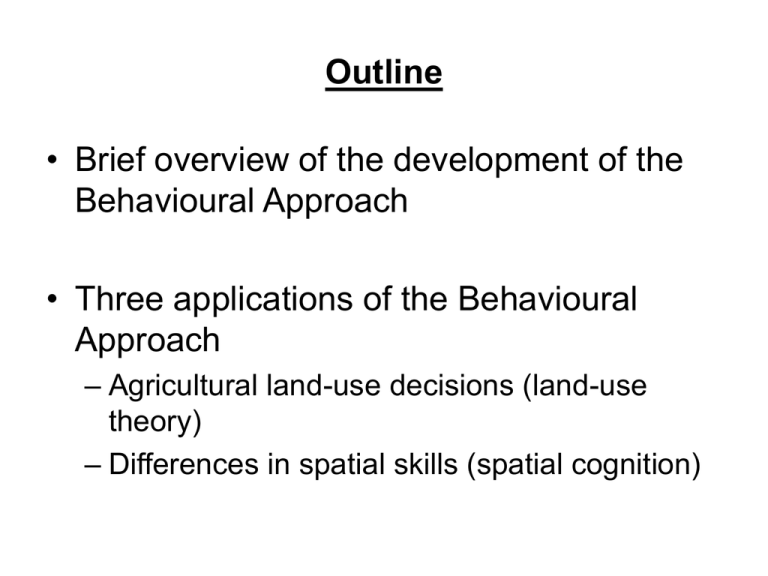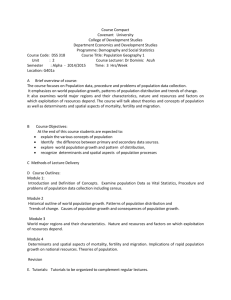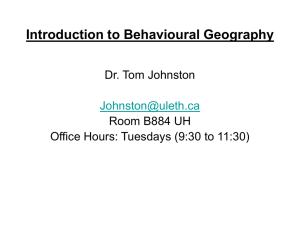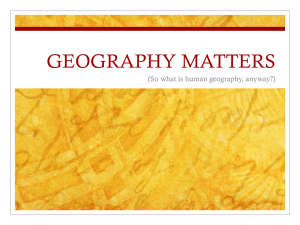Johnston - Behavioural Geography II
advertisement

Outline • Brief overview of the development of the Behavioural Approach • Three applications of the Behavioural Approach – Agricultural land-use decisions (land-use theory) – Differences in spatial skills (spatial cognition) Outline for Lecture No. 2 • Continue overview of the development of the Behavioural Approach • Simon’s Satisficer Theory • Golledge and Simspon’s Cognitive Map Model • The Behavioural Approach and Land-use Theory Foundations for the Emergence of the “New” Geography • Regional perspective was not regarded as a science • Edward Ackerman (1945) argued that: – During WWII many regional specialists “lacked the competence in topical and systematic subjects” Geography and the Regional Perspective • Following demise of ED, the regional perspective dominated • Regional perspective emphasized detailed study of specific regions, synthesizing knowledge from many systematic disciplines • Emphasized Areal Differentiation According to Richard Hartshorne (1939), the goal of geography was to ……. “provide an orderly and rational description and interpretation of the variable character of the earth’s surface” NB: definition does not include any reference to explanation, prediction, search for laws, or empirical verification. Foundations for the Emergence of the “New” Geography • Regional perspective was not regarded as a science • Edward Ackerman (1945) argued that: – During WWII many regional specialists “lacked the competence in topical and systematic subjects” Foundations for the Emergence of the “New” Geography (cont’d) • 1953 Frederick Schaefer publishes “Exceptionalsim in Geography” • Geography should shift focus from the general to the specific (systematic focus) • Geography should adopt of the basic objective of science • And that geography should adopt the methods, techniques and “language” of science Adoption of Logical Positivism and Neo-classical Economic Determinism • Iowa State geography dept at the forefront • Scheafer had been influenced by Gustav Bergmann who had been a member of the “Vienna Circle” • Several other members at Iowa adopted notion of “Homo Economus” Neo-classical Economic Determinism Challenged….. • Neo-classical economic determinism dominated human (economic) geography until late 1960s • Predictions grounded in optimization, principle of least effort or profit maximization were found wanting – too many anomalies • E.g. how do we explain decisions that are “good enough” (feasible) but not “the best” (optimal)? Simon’s Satisficer Theroy • We are rational decision makers – even when decisions are sub-optimal • Simon’s Central Idea = When making decisions, we taken a range of considerations into account B A Environmental Information Personality Experiences Perceptual Filters Culture Gender Class Ethnicity Cognitive Map Cognitive Map Model by Reginald Golledge and Robert Simpson Applying the Behavioural Approach to Agricultural Land Use Theory • J.H. von Thunen first proposed his theory of agricultural land use in 1842 – known as “Rent Theory” • Rent theory predicts that any given parcel of land will be used for (allocated to / devoted to) the “Highest and Best Use” • Thunian land-use patterns widely documented but not universal (anomalies) Goals and Values of Farmers • 1973 Prof. Ruth Gasson publishes seminal paper on the goal and values of farmers. • Agricultural land-use patterns deviate from the “ideal” because maximizing profits – which Rent Theory assumes – is not the only factor farmers take into consideration. Goals and Values of Farmers (cont’d_ • Gasson argued that farmers reference four groupings of values … • • • • Intrinsic (an activity valued in its own right) Expressive (a means of self expression) Instrumental (means of earning income) Social (done for sake of interpersonal relationships) Ilbery, B.W. 1983, “Goals and values of hop farmers”, Transactions of the Institute of British Geographers, Vol. 8: 329-341. Ilbery’s Study of Hop Farmers in Herefordshire and Worcestershire • Surveyed 127 hop farmers • Respondents shown a list of 20 reasons • Each scored as follows: • • • • • Essential = 4 Very important = 3 Important = 2 Not really important = 1 Irrelevant = 0 Top Five Reasons Rank 1 2 3 4 5 Reason Value Total Score Doing the work you like Independence Intrinsic 342 Intrinsic 340 Satisfactory income Respect of workers Self-respect for doing a good job Instrumental 335 Social 329 Expressive 323 Here’s another example ….. • Smit, B. et al., 1997, “Corn hybrid selection and climatic variability: Gambling with nature?” The Canadian Geographer, 41 (4): 429-438. • Found that after the (warm) year of 1991, a statistically significant number of farmers selected longer-maturing and potentially higher-yielding, but riskier varieties. • After the lower CHU years of 1992 and 1993, farmers' hybrid selections became markedly more conservative. Gender-related differences in Spatial Skills • Women are underrepresented in jobs requiring application of spatial skills. • Some have argued this is because women’s spatial skills are inferior. • Self, C.M. et al., 1992, “Gender-related differences in spatial abilities”, Progress in Human Geography, Vol.16(3): 315-342. Spatial abilities include: (1) Spatial orientation: ability to imagine how an object would look from another perspective. (2) Spatial visualization: ability to mentally manipulate an object (e.g., mental rotation). (3) Spatial relations: ability to identify and analyze spatial patterns and associations. Theories Advanced to Account for Male/Female Differences • Deficiency Theory: differences are biologically based. • Difference Theory: differences grounded in sociocultural processes. • Inefficiency Theory: performance and behaviour indicators used tend to favour males. Self et al. conclude ….. • There is growing evidence that gender-based differences in spatial skills are narrowing. • This has happened at the same time that male and female activity patterns have become more similar • Therefore, observed differences may be largely the result of sociocultural processes To Summarize • One of several approaches used by human geographers. • Focuses on cognitive processes underlying geographic behaviour. • These include perception, cognition, values and attitudes. • Attempts to account for sub-optimal decisions and behaviours To Summarize • Behavioural Geography one of several approaches used to understand human geographic behaviour • Questions range from wayfinding to resource allocations decisions • Response to limitations with Neo-classical Economic Determinism • Draws on psychology (but other disciplines too!)






